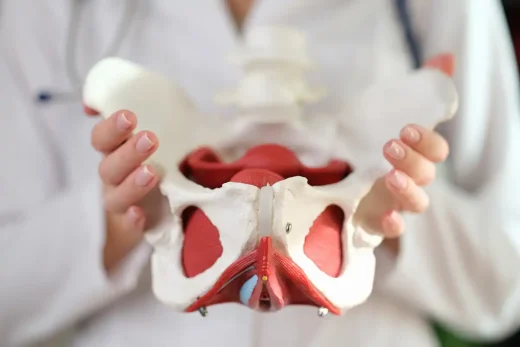There’s a unique kind of silence that comes from enduring pain day after day. Not the acute kind that demands a scream but the dull, dragging weight of a hip joint that just won’t let you live freely. For many people, especially as they age or deal with chronic joint disease, hip pain becomes more than a medical issue. It becomes an identity shift.
You stop dancing. You park closer. You decline invites. You start planning life around the pain instead of letting life unfold naturally. But here’s the good news: hip replacement surgery doesn’t just fix a joint it gives people back the life they thought they lost.

More Than an Operation
Total hip replacement, or total hip arthroplasty, is often viewed through a narrow lens, one that focuses on x-rays, surgical tools, and hospital gowns. But ask any patient who’s undergone the procedure, and you’ll hear something deeper: “I feel like myself again.”
Mobility is freedom. It’s being able to walk your dog without worrying about sharp pain halfway through. It’s playing with your grandchildren instead of watching from the sidelines. It’s standing up from your chair without needing to plan it like a mission.
When mobility returns, confidence follows. And for many, that’s the most powerful change of all.
What Happens During a Hip Replacement?
Let’s take a step back and explain what the procedure involves, medically speaking. Hip replacement is a surgical procedure where the damaged parts of the hip joint typically due to arthritis, injury, or wear are replaced with artificial components made of metal, ceramic, or plastic.
A standard hip replacement includes:
- Removing the damaged femoral head
- Inserting a metal stem into the femur
- Placing a ball on top of the stem
- Inserting a new socket into the pelvic bone
- Adding a spacer for smooth joint movement
This can be done through traditional, minimally invasive, or even robot-assisted techniques each offering varying recovery times and levels of precision.
The Emotional Weight of Chronic Pain
There’s a reason so many people delay surgery, even when they’re technically “eligible.” Chronic pain wears down more than your joints; it dulls your social life, alters your mood, and changes your sense of control.
It’s not uncommon for patients to go through periods of depression or anxiety before surgery. You might feel guilty for needing help, ashamed of your limitations, or afraid of what surgery entails. These are all normal, human responses.
What many don’t realize is how quickly that fog lifts after surgery. Within a few weeks, patients often report:
- Better sleep
- Improved mood
- A renewed sense of independence
- Increased energy levels due to reduced inflammation and fatigue
In short: when the pain lifts, so does the weight on your mind.
A Modern Solution for All Ages
There’s a common misconception that hip replacements are only for people over 70. While age used to be a defining factor, today’s surgical techniques and durable implants mean younger, more active individuals are increasingly opting for surgery to maintain their lifestyle.
Whether you’re 45 and still working full-time or 65 and planning your retirement travel goals, hip replacement can meet you where you are offering a way to keep moving, working, and living on your own terms.
Modern prosthetics can last 20+ years with proper care, especially in patients who stay active without putting excess strain on the new joint.
What Recovery Really Looks Like
Let’s be honest, recovery isn’t always pretty. There will be discomfort, physical therapy, and days you’ll question whether you made the right decision. But here’s what’s equally true: every day, it gets better.
A typical recovery journey includes:
- Days 1–3: Hospital stay, pain management, learning to walk again with a walker or crutches.
- Weeks 1–2: Transitioning to walking aids at home, beginning light exercises.
- Weeks 3–6: More confident walking, driving may resume, return to desk jobs.
- Weeks 7–12: Strength building, stairs become easier, most daily activities resume.
The key is consistency, sticking to your physical therapy plan, eating well, managing your sleep, and asking for support when you need it.
The Psychological Boost of Saying “Yes” to Yourself
What’s often overlooked in clinical consultations is this: choosing to get a hip replacement is an act of self-advocacy. It means you’ve decided that life is meant to be lived fully, not tiptoed around.
That moment when you walk around the block pain-free for the first time? It’s not just a physical triumph. It’s proof that your courage paid off. That you’re not “broken” or “aging” you’re healing.
This kind of transformation doesn’t just happen in operating rooms. It happens in how you look in the mirror, how you show up to your relationships, and how you speak about your future.
Global Options and Accessible Care
For many people in the U.S., U.K., or Western Europe, access to hip replacement surgery comes with its own burdens: long waitlists, high costs, or limited surgeon availability.
That’s why medical tourism has become an increasingly popular option especially in places like Turkey, where hospitals like Erdem Hospital offer internationally accredited orthopedic programs at more affordable rates.
Erdem Hospital, for example, provides:
- English-speaking care teams
- Customized surgical planning and rehabilitation
- Seamless coordination between pre-op and aftercare
- Comfortable hospital and hotel packages
- Short recovery stays with full transparency in pricing
For patients traveling from abroad, this holistic approach ensures that the process is not just safe, but emotionally supportive.
You Deserve to Walk Freely
You’re not weak for considering surgery. You’re not rushing things. You’re choosing a path that countless others have walked toward better health, fuller movement, and a richer everyday life.
If hip pain is keeping you from the moments that matter whether it’s a morning stroll, a vacation, or just a peaceful night’s sleep then it may be time to reclaim your independence.
Because sometimes, getting back on your feet means finally choosing yourself.
Looking for a trusted place to begin your recovery?

Erdem Hospital in Istanbul has helped thousands of patients worldwide walk again with confidence. With experienced orthopedic surgeons, compassionate caregivers, and seamless international support, we’re here to walk beside you every step of the way.
Let’s get you back on your feet.